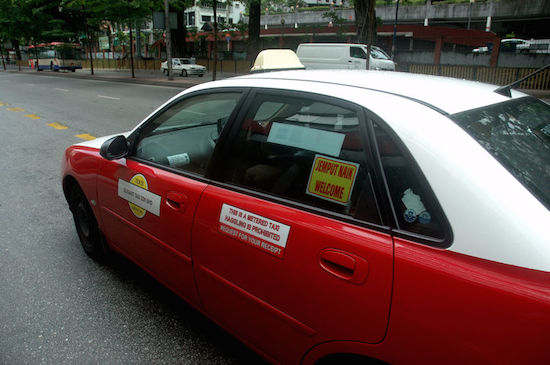GrabTaxi reaffirms focus on SEA, raises US$65mil in Series C
By Gabey Goh October 21, 2014
- Funding used to expand headcount, driver welfare programmes
- Reaffirms its focus on being a SEA-centric service company

Known as MyTeksi in Malaysia but GrabTaxi regionally, the company declared that it had raised a “total of approximately US$90 million of venture capitalist funding and loans within the last 12 months.”
Given its Series A round of US$10 million and its Series B round of US$15 million, this Series C round is approximated at US$65 million, a sum being touted as one of the largest investments made in a South-East Asian startup.
The round was led by Tiger Global Management, a US$4-billion hedge fund headquartered in New York that has previously invested in startups such as SurveyMonkey, Quora and FlipKart.
Existing investors Vertex Venture Holdings, GGV Capital and Qunar also re-invested in this round and were joined by a new investor, Hillhouse Capital Management, a Beijing-based hedge fund with a US$889-million portfolio that has made investments in companies such as Tencent Holdings and Qunar.
GrabTaxi founder and group chief executive officer Anthony Tan (pic) said the amount raised and investors on board signalled “confidence” in the company and its mission.
He was tight-lipped on details, declining to give a valuation figure but declaring that the company "has been blessed to be able to raise a significant war chest." He also declined to reveal the exact amount of Series C funding raised, adding that this was to “keep things mysterious."
Asked what milestones in particular were attached to this round of funding, Tan’s response was “to grow as fast and as big as possible.” He did however reveal that new shares were issued in this round, comprising a mix of ordinary and preference share options.
Instead of asnwering further questions raised, Tan spent much of the press briefing talking about the impact services such as GrabTaxi have made in the lives of customers and drivers.
He cited initiatives such as the one launched in Malaysia earlier this month, which enables taxi drivers in the Klang Valley to become “the eyes and ears of the police force.”
According to a report by Malay Mail Online, at least 10,000 taxi drivers utilising the MyTeksi smartphone app will be able to report a crime, an accident or provide a tip-off.
“It’s about pushing boundaries and making a difference in people’s lives. That’s our differentiator; we work with governments as constructive disruptors, doing so within local rules and regulations to make a difference,” Tan said in a subtle dig at Uber, which has had some run-ins with local regulators since its expansion into the region.
Tan said the company also works with the police force in Singapore and the Philippines.
GrabTaxi is currently present in 16 cities in six countries across South-East Asia, with a 17th city expected to be announced soon. It claims its app has been downloaded more than 2.1 million times to date, and boasts 400,000 monthly active users with two bookings made every second across the platform. It also claims to have more than 50,000 drivers in its network.
This is compared with its figures in May, when GrabTaxi was said to have had 1.2 million downloads and 250,000 monthly users.
GrabTaxi general manager for Singapore Lim Kell Jay said there are over 967,000 cab rides a day in the island, but only 5% of bookings were via apps. Another 5% are done via other forms and the remaining 90% via street hails.
Of the 5% of app bookings, it it unclear how many were attributed directly to GrabTaxi compared with its competitors. Lim was however optimistic that this ratio could change and that there are opportunities to convert more consumers to booking a taxi via an app as opposed to calling or hailing one.

The race for dominance
Quizzed on how confident the company was in its leadership position in the region -- given that competitors such as Rocket Internet’s EasyTaxi and Silicon Valley’s Uber, with large funding rounds and global presence were all embarking on the same tactic of burning money to gain market share -- Tan said without commenting further, “I wouldn’t call what we do ‘burning money.’ I would call it investing money to make a difference.”
In July, GrabTaxi’s closest competitor EasyTaxi raised U$40 million in Series D funding in a round led by the Russian-based Phenomen Ventures, with the participation of Tengelmann Ventures, the investment company of Germany’s multi-sector retailer Tengelmann Group.
This puts Easy Taxi’s total funding at US$77 million, with existing operations in 32 countries and 162 cities worldwide. By comparison Uber, which operates in 45 countries, recently received US$1.5 billion in venture capital at a valuation of US$17 billion.
In addition to similar competitors in the app space, GrabTaxi also faces resistance from taxi fleets with their own booking systems in place.
“I can tell you that most fleets today, regardless of which city, strongly discourage the use of services like ours. A few have banned us and we’re still here today,” Tan said.
Asked how the company gets around such restrictions, he said the team works directly with the drivers themselves.
GrabTaxi remains committed and focused on the South-East Asia, with no immediate plans to expand beyond the region, he added.
Asked about its leadership position in the market, Tan said the company was “blessed” to hold a No 1 position in all of the markets it has a presence in.
However, when queried by Digital News Asia (DNA), an EasyTaxi executive rebuffed such claims, adding that it was more of a "neck and neck fight," one that remained in a flux across the region with the exception of its home market Malaysia, where GrabTaxi maintains a lead.
Tan said that while competitors were global in their outlook with a focus on major cities and hubs, it was his company’s mission to expand its footprint beyond that to smaller cities and hubs.
“The opportunity is there. There are people who would take a cab from Penang to Kuala Lumpur, and then to Johor Baru or Singapore. And we want to enable that interconnectivity for consumers,” he explained.
The company is also experimenting with motorcycle taxis in Vietnam but it remains a trial venture.
When asked about GrabCar, the company’s own premium limousine offering which the company launched earlier in the year, Tan said that it was “doing well” but it remains available only in a handful of markets.
Tan also said the company wished to be seen as a “source of inspiration” for aspiring entrepreneurs in the region, issuing a “challenge” to have faith and for the media to “spread the word.”
“My message is that if you have the cojones to fight and stand up against the giants, then there will be investors and teammates who will believe in you and your mission,” he declared.
He also said he welcomed more competition in the market, adding that education and awareness with taxi drivers remain an on-going effort, and that more competition would accelerate that maturity level.
New funds
Meanwhile, GrabTaxi said the new round of funding would be channelled towards launching community programmes to reward drivers and passengers. It will also expand its plans to offer drivers insurance plans and continue its outreach to sign up new drivers.
In Malaysia, there are plans to launch educational and social programmes for taxi drivers and their families, including refurbishing their taxis. In Singapore, the company is organising a nationwide roadshow in November in conjunction with its first anniversary, offering drivers over S$100 (US$79) worth of cash, credits and giveaways
The funding will also drive an aggressive recruitment campaign to expand its team, with 15 positions needing to be filled across all functions in the Singapore office alone.
Tan also revealed that there would be a particular focus on hiring data scientists to help the company further understand and serve its customers.
An industry source DNA spoke to claimed that many of the company's original engineers were leaving. When asked to comment on this, Tan flatly denied it, saying it was “untrue.”
“We’re all part of the Grab family here. We work hard but also take care of each other like a family, although we do take performance seriously,” he said.
On revenue figures and which market it was the strongest in, Tan declined to reveal any details, saying the company prefers to take a regional view of its operations and only distinguishes between mature and non-mature markets based on how long the company has been on the ground.
He did however reveal that its fastest growing markets were outside of Singapore and Malaysia.
Share details
According to its filing with the Companies Commission of Malaysia, GrabTaxi recorded revenue of RM1,284,726 (US$394,269) for its financial year ending Dec 31, 2013 in that country alone. It recorded a loss of RM3,297,783 (US$1,011,280).
Under GrabTaxi Holdings, in its profile filed in Singapore with the Accounting and Corporate Regulatory Authority (ACRA) accessed by DNA on Oct 15, a total of 1,246,723 preference shares and 565,209 ordinary shares were issued by the company.
Preference shares are a special class of shares that may have any combination of features not possessed by ordinary shares, such as reference in dividends or assets, in the event of liquidation or convertibility to ordinary shares. However, it is unknown what features are attached to GrabTaxi’s preferred shares.
As of Dec 31, 2013, of the issued preference shares, Vertex holds 28% (354,647 shares) while GGV Capital holds 22% (270,649 shares), with another 5,738 shares or 0.21% stake under its Entrepreneur Fund.
500 Durians, the South-East Asia fund of 500 Startups, holds 2,402 ordinary shares (0.42%) while founder Tan holds 259,200 ordinary shares (46%) and 81,951 preference shares (6.8%).
Other sizeable investors include Perfect Dragon Investments Limited with 9.18% (114,510 preference shares) and Tiger Global with 21.9% or 273,662 preference shares.
Given that the Series C funding was led by Tiger Global, this new round may have catapulted the firm to becoming the biggest "holder" of preference shares.
However, with its Series C funding round and inclusion of a new investor, these shares and figures will change. Updated information is expected to be available some time next year when the company files its 2014 financial results data with ACRA.
Independent technology consultant Derek Chong, in response to queries from DNA, noted that heavy investor interest and support could signal some sizeable returns on investment in a battle that is largely determined by high capital investments.
“With the proven success of Uber and the state of the South-East Asian taxi market, it's clear there's a huge segment to be captured. The current fight for market share is strong evidence of investor confidence in the long-term potential in the region,” he added.
However, the end game remains unclear at this stage, with all competitors still fighting it out for dominance and no clear exit strategies.
"It's not yet clear whether this kind of fight for a bigger slice of the pie is sustainable with each company attempting to buy market share in a crowded space," Chong said. "The only sure winners so far, are the consumers in this on-going 'taxi app' wars."
Related Stories:
GrabTaxi raises Series A for undisclosed amount
GrabTaxi announces US$15 million Series B funding
Easy Taxi raises US$40mil from new investors
EasyTaxi continues rapid ride, eyes Asian expansion
For more technology news and the latest updates, follow us on Twitter, LinkedIn or Like us on Facebook.


